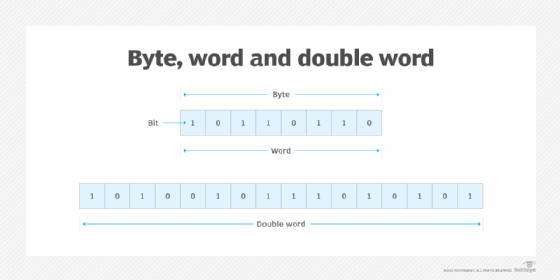word (in computing)
What is a word in computing?
In computer architecture, a word is a unit of data of a defined bit length that can be addressed and moved between storage and the computer processor. Usually, the defined bit length of a word is equivalent to the width of the computer's data bus so that a word can be moved in a single operation from storage to a processor register. For any computer architecture with an 8-bit byte, the word size is some multiple of 8 bits. In IBM's System/360 mainframe architecture, a word is 32 bits, or four contiguous 8-bit bytes. In Intel's PC processor architecture, a word is 16 bits, or two contiguous 8-bit bytes.
In general, the longer the architected word length, the more the computer system processor can do in a single operation.
Word sizes in computer architectures
Some computer processor architectures support a half word, which is half the number of bits in a word, and a double word, which is two contiguous words. Intel's processor architecture also supports a quad word, or two contiguous double words, and a double quad word, or two contiguous quad words. Figure 1 depicts examples of an 8-bit byte, 8-bit word and 16-bit double word.

Functions of a computer word
A word can contain a computer instruction, a storage address or application data that is manipulated -- for example, added to the data in another word space. In some architectures, a double word or larger unit is required to contain an instruction, address or application data. Typically, an instruction is a word in length, but some architectures support half word- and double word-length instructions.
A computer's word size is typically a function of the computer's design and how it moves data bits within the various system elements. For example, registers are important holders for various system functions, such as addressing, and the word size is likely to be the size accepted by the computer.
Here's how words are used in a system:
- Fixed-point numbers. These are numerical values that typically include a standard word and can have different bit counts for various activities.
- Floating-point numbers. These are numerical values that have a minimum size of one word and can also have multiple word sizes using the basic word.
- Addresses. Used for memory, addresses can be a single word or multiples/fractions of that word.
- Registers. These are used to hold data in preparation for processing and can support data sizes ranging from standard words to fixed- and floating-point numbers, as well as other combinations.
- Memory-processor transfer. The movement of data from memory to central processing units (CPUs) typically uses registers that support the word size used by memory, usually a single word. However, depending on the system, variable word sizes may also be used.
- Instructions. Computing functions are executed using a variety of instructions that are typically formatted in the same size as the word used in the computer's architecture.
Importance of word size
The word size is an important design decision that is made during the design phase of a computing system. It becomes the foundation upon which the computer's capabilities are based. Once the word size has been decided, the architecture can be designed to accommodate multiple word sizes, such as double words, as part of the overall processing environment.
For example, Microsoft's Windows operating system uses a 16-bit word as its foundation. Multiples of the 16-bit word size can be accommodated based on the type of Intel processor being used. An Intel x86 processor can support 32-bit or 64-bit words, which are then used to support Microsoft (and other vendor) applications (e.g., Word), various programming languages and application programming interfaces.
By contrast, traditional IBM mainframe platforms, such as System/360, System/370 and System/390, use 8-bit bytes, 16-bit half words, 32-bit words and 64-bit double words.
While they both execute some of the same computer tasks, their functions differ slightly. Learn how CPUs and microprocessors differ.
